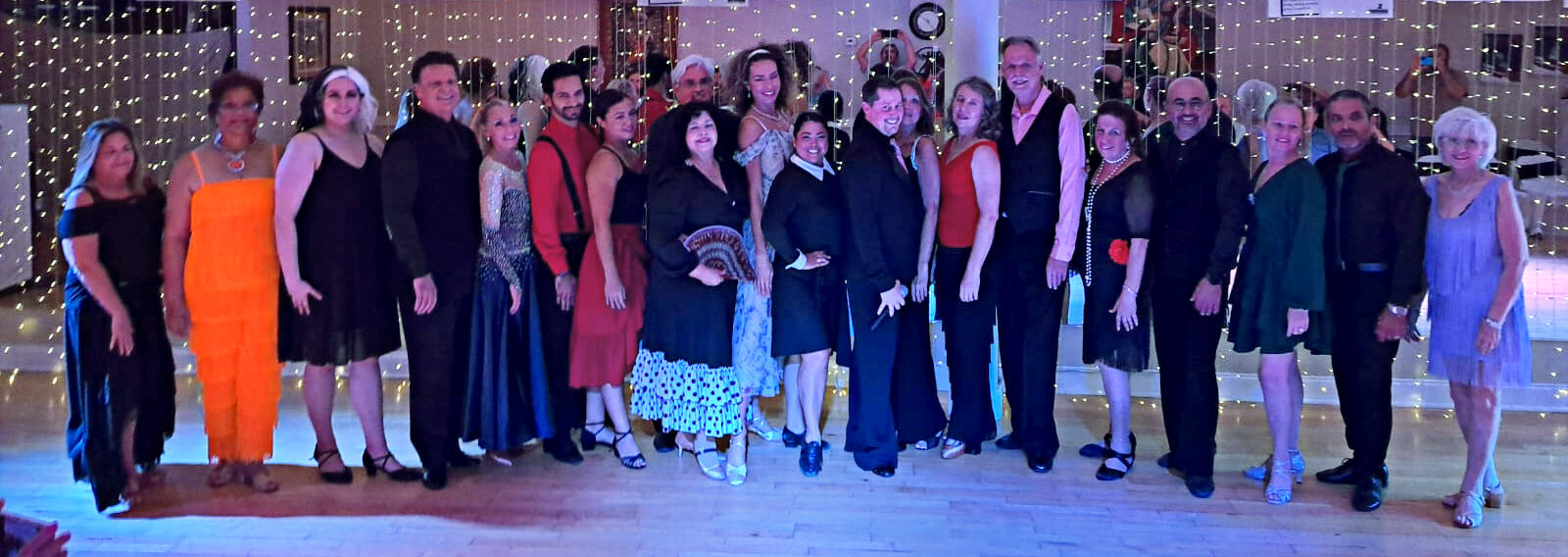Your cart is currently empty!
New Student Special: Join us JUNE 16th – 19th, for NO CHARGE group classes at 7:00PM. (NEW STUDENTS ONLY)

FAQs
General
Q. How do I sign up for classes?
A. Simply call, or come in. Together we’ll figure out what is best for you. Or, if you know you want Private Lessons but don’t know how to start, try our “Introductory Special”. It’s 3 Private Lessons for ONLY $30/p. We’ll introduce you to the FUNdamentals of dancing. For Group Classes, just arrive about 5 minutes before class. Check our calendar for a schedule of classes.
Q. Do I need a partner?
A. No. If taking private lessons your instructor will be your partner. This accelerates your learning by 300% because all of the attention is on you. Everyone attending the group classes and in-studio practice parties will also be your partner. You will have many dance partners as well as make a new friend or two.
Q. I don’t know anything at all. Can you still teach me?
A. Believe it or not, people do call asking if they need talent or prior dance knowledge as a pre-requisite. Contrary to popular belief, YOU DO NOT HAVE TO BE TALENTED to be a good dancer. Every so called “talented” dancer that I’ve spoken with have all confessed. Desire and practice was their secret to their success. So yes, you have what it takes. Another statement we hear all the time is “I have two left feet”. We are a dance school. We will teach you from the ground up, no matter what level or how bad you think you are. There has NEVER been a person we coluldn’t teach quickly. The hardest part is picking up the phone to schedule your first lesson.
Q. How does your method of teaching ensure that I will learn?
A. ADC’s instructors are all fully trained, certified, and have years of experience. Our 3 tier approach ensures that you learn at a consistant pace and are always moving forward. We train your body to retain and execute what you’ve learned through muscle memory. Group Classes are great for learning the construction of patterns as well as trying them alongside peers with the same interest. Private Lessons teach you how to lead or follow one pattern into the next with technique as well as how to stay on time to the music. Lastly, our In-Studio Practice Parties offer you the chance to apply what you’ve learned from your group and private lessons under the supervision of our caring instructors and other students. Once you feel comfortable dancing with us, you know you are ready to go try your new skill out. All of our Private Lesson packages include Group Classes and In-Studio Parties. We know our 3 tier approach is the most proven way to achieve whatever your goal in the fastest amount of time.
Q. Can You Teach Someone That Has No Rhythm?
A. We hear that concern all the time. Rhythm is defined as “A pattern of regular recurring beats”. Although some people can hear a recurring thump in a song, nobody is able to identify the Salsa rhythm or Rumba rhythm in a song (no matter how rhythmical they may be) without first being taught what to listen for. Only then, can you understand which beats you should actually dance to. There is really noone being born with rhythm or “that rhythm is in the blood”. Anybody can learn to dance!
Q. What are the length of your classes?
A. Group and Private Classes are 50 minutes each, and our “Dance Parties”are 2 hours of fun with a 50 minute beginner group class before the party starts. The beginner’s program, or “Introductory Special” is three – 30 minute long Private Lessons.
Q. I’ve danced my whole life but never had lessons. Do I start with beginner, advanced, private, or group lessons?
A. Partner-style dancing (aka Ballroom and Latin) requires structure for two people to move together as one, we recommend that you start with beginner level Private or Group Classes. Even if you have danced before it will benefit you to learn the dance jargon and elements that make up our dance bible. Once class is over, the attending instructor will determine (upon request) whether you are in the right place, or if you need more of a challenge. Come in or call during studio hours to speak with a dance specialist and we’ll help you determine the best place to start. Also, you will become more aware of your goals and how to achieve them with experience. Let your instructor know of any change so we may tailor your lessons toward that direction.
Q. How long will it be before I feel like I’m a confident dancer?
A. Everybody differs on their curve of learning. In most cases we’ve found that it takes an average of 6 months (two times per week) to feel totally confident with a few dances. The first dance is always the hardest and takes the longest to learn. This happens because it is foreign and new. First, you learn how to lead with power (or follow by calming your thoughts and waiting for his signals) through the use of a frame that stays rigid. Then, you learn to change weight efficiently from one foot to the other (while staying on time to a rhythm). Once good habits and dance elements are well established, the 2nd, 3rd, and 4th dance can be learned 5-6 times faster.As with any sport, success depends on your personal commitment. With a good foundation, some dedication and repetitive practice, you create the muscle memory required to be a good social or competitve dancer. Your confidence and fluency build on their own and soon you find you are losing yourself in the music while dancing.
Q. When I think of Ballroom Dancing, I think of what my grandparents used to do. I want to learn faster dances like Salsa. Does ADC teach that too?
A. Absolutely! The term “Ballroom Dancing” is loosely used as a general term to describe any dance that is done with a partner. Ballroom Dancing is: Salsa, Merengue, Samba, Cha Cha, Mambo, Tango, Bolero, NightClub Two-Step, Country Two-Step, Paso Doble, Quickstep, Waltz, Foxtrot, Viennese Waltz, Argentine Tango, Disco-Hustle, Bachata, and any of the Swing Dancing styles (i.e. Jitterbug, Jive, Lindy Hop, East Coast Swing, West Coast Swing, and Shag). There is not any partner dance that ADC can not teach.
Q. How Long Will It Take Me To Feel Comfortable On The Dance Floor?
A. By the way, everybody’s definition of comfortable is different. I consider “comfortable” to mean to blend in with the rest of the crowd on the dance floor. An average of 2 lessons per week are a reference. Next, we need to understand where you plan on dancing.
a) At a “Dance Hall” where all Ballroom, Latin, and Nightclub music is played, you probably want to know at least 6-8 different dances so you can dance the night away without sitting too much. This should take about 9-12 months so you get a nice variety of dances and patterns under your belt.
b) For “Latin Club” dancing, where generally Salsa, Bachata, and Merengue music is mostly played, should take you about 4-6 months.
c) For “Nightclub/Lounge/Restaurant” dancing where a wide variety of today’s popular songs will be played, probably about 6-8 months. A lot of today’s music is pop, techno, hip hop or some kind of fusion. This brand of upbeat music is designed to keep the crowd pumped and awake. Here Hustle, Cha Cha, Swing, Merengue, and Rumba are dances that can be used. If you want to dance with someone or by yourself, you should get comfortable understanding and playing around with these rhythms and steps.
Q. I want to dance but how do I begin?
A. This is common. You’re excited to start but don’t know how. Try our “Beginner’s Special”. It’s 3 separate 30 minute private dance sessions. In that short amount of time we’ll find out what you wish to accomplish, where you are starting from in the dance process, and recommend how to reach your goals.
Q. I am a single man and I love latin music. What would you teach me?
A. We will pair you with a female instructor who will also be your partner during the lessons. She will show you how to lead a woman in Salsa, Merengue, and Bachata. At first, quantity of steps is not important. Any woman would rather dance with a man that can lead 4 patterns, while staying on time to music, versus a man that can execute 10 patterns but has no ability to guide the woman, and can’t hear or stay on the rhythm of the music.
Q. What Do I Need To Be A Good Dancer?
A. We’ve established in an above question that neither talent nor genetics plays a part in whether or not a person will be a good dancer. Let’s talk about what tools one will need. Desire to learn, commitment, and patience! That’s all. If you make the phone call and show up to your first lesson, we’ll make the learning process fun and easy. Most people say the same thing once they’ve started. “We wish we would have not put it off for such a long time. Had we known it was this much fun and easy, we would have started years ago.” -actually comment we hear all the time
Q. Do you offer children’s classes?
A. We have special private youth classes at a discounted rate for children 6-17.FACT: Youths 6-17 years of age learn 3-4 times faster than an adult. We like to take advantage of this by teaching them high level routines. Routines they can then take home and practice between lessons. This method of instruction benefits them greatly in many ways both in the present and in the future. Youths can dance at competitions with their instructor or with a sibling as a brother-sister team. Aside from learning to dance, the process teaches them respect for the opposite sex. Ballroom youths attain better focus and do better in school. They acquire self discipline and exude higher confidence. When they get older, they already know how to dance, resulting in greater confidence at social functions and generally in any and all social situations.
Q. I see a lot of different dance styles and almost feel overwhelmed. How can I learn even 4 different dances without getting confused?
A. Confusion is normal in the beginning. After about your 4th or 5th Private Lesson the cloudiness will clear up and start to make sense how things work together. Most dances have interrelated patterns. This means if you learn 7 patterns in the Rumba, well congratulations, because you’ve unknowingly just learned the same 7 patterns you can use in the Salsa, the Cha Cha, the Mambo, and the Bolero. The only difference between those 4 dances will be the characteristics of the dance. Meaning, the “Basic Step” and rhythm of each dance. Once you understand this, you’ll see how easy it is to apply each of those 7 patterns in all 4 dances. And that interrelated concept will hold true for ANY AND ALL of the dances you want to learn. We instructors say, “Why learn to follow one dance when you can learn to follow?”
Wedding Dances
Q. How important is it for us to have a choreographed wedding dance?
A. Your wedding dance is as important an event as the food, setup, and other wedding plans. Aside from your guests watching, it will also be captured by your videographer. Every time you watch your wedding video you want be reminded of the beautiful night it was. Not of the awkward dance moment captured on video that was uncomfortable for you and everybody in attendance.
Q. What do I need to prepare for my wedding dance?
A. On your wedding day we want you to look natural and flow effortlessly to your song. This dance should be performed to a song that has a special meaning to both of you. We don’t want you to appear that you are concentrating, look scared, nervous, or that you’ve taken lessons. So, you’ll want time to learn the choreography, and then once or twice a week to rehearse it. It can take as little as 2 months for something very basic or up to 8 months for something extremely elaborate. We just need you to know the size of the dance floor and to bring in a CD (or flash drive) with your special song plus, an additional “backup” song. (Every once in a while, a couple has a song that has great lyrics but absolutely no discernable rhythm. Although as professionals we can always fit a rhythm to your song, it might be hard for you to hear, or stay on time to the rhythm. That’s why it’s a good idea to think about having a backup song, just in case. Also, you’ll want to bring the shoes you’ll be wearing on your wedding day. Don’t worry ladies. It’s only the shoes he’ll have a preview of, not your dress.)
Q. We want to stand out on our wedding day, how many lessons will we need?
A. This depends on if your goal is to “wow” your guests, or simply get through your dance comfortably. Either way, we’ll make sure you look better than that routine of swaying from side to side you see at many weddings. Our smallest wedding package is 5 private lessons. This will be enough to give you a few moves that will make you stand out from most wedding dances you’ve seen. If you want, we can customize a program for your first dance and also give you the ability to dance the night away with the rest of the music that will be played on your special day. We even have programs designed for your father-daughter dance, mother-son dance, and/or your entire wedding party.
Dance Competitions
Q. What are the dance competitions like and what does it take to participate?
A. You can participate in any of the four competitions we usually participate in each year. Students should take at least 20 private dance lessons learning how to freestyle (lead/follow). Then, commit a set number of lessons to prepare to compete in your age category, in the specific dances, and in the pre-set attainable bronze levels. For example competing in Cha Cha at newcomer level means five patterns in a routine format. This should take about 5 private lessons dedicated to the competition.
These competitions complete the amateur dance experience. They include amazing professional dance shows, gourmet dinners, an exciting energy charged atmosphere, glamour, glitz, general dancing with our studio as well as other studio instructors and students!
Q. What if I just want to come to the competition and watch?
A. If unsure that you want to compete, start as a spectator. Go see what it’s all about! You can cheer and support the ADC studio and participating students. You will always be welcome to come watch. If you want to sit with the studio table, you will need to remember to purchase your tickets in advance through the studio.
We are happy to answer any additional questions. Please feel free to call the studio at 561.558.1234 Monday through Friday from 1:00 pm to 9:00 pm or email us at Anybodycandance@gmail.com


